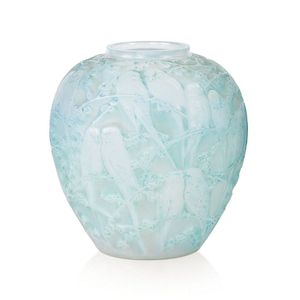Opalescent Lalique Perruches Vase with Parakeets and Blue Patina
You must be a subscriber, and be logged in to view price and dealer details.
Subscribe Now to view actual auction price for this item
When you subscribe, you have the option of setting the currency in which to display prices to $Au, $US, $NZ or Stg.
- Baluster (glass) - An architectural term for a column in a balustrade or staircase.
When used to describe glass, it can either refer to the shape of the stem of a wine glass, being slender above and pear shaped below, or the shape of the whole vessel, usually a vase. In fact the baluster shape is often described as being vase-like.
The description of a vase as being of baluster shape covers a wide variety of shapes that often bear no resemblance to the original architectural form. - Patination / Patina - In broad terms, patination refers to the exterior surface appearance of the timber, the effect of fading caused by exposure to sunlight and air over the course of a century or more, changing the piece to a soft, mellow colour.
As patina is very difficult to replicate, it is one of the most important guides to determining the age of furniture.
Patina is also the term applied to the bloom or film found on old bronzes due to oxidisation. - Opalescent / Opaline - The descriptions of glass as "opalescent" or "opaline" are often used interchangeably by dealers and auction houses. At the upper end of the scale, opalescent / opaline glass can refer to the opal-like milky blue glass produced by Lalique and Etling. It also refers to the pressed glass mass produced in Britain from the 1840s with a milky white edge as sugar-basins, milk jugs and vases were made in great quantities for the mass market, and were sold at fairs along with Staffordshire figures and wooden dolls. A less common type of opalescent glass was made from two layers of glass blown into a mould.
This item has been included into following indexes:
-
Lalique (France), item types
- other items 1,071
- vases 546
- Lalique (France), patterns, plates and bowls - Perruches 14
- Lalique (France), patterns, vases - Perruches 13
- Schneider / Le Verre Francais (France) - lamps and lighting 303
Visually similar items

A Rene Lalique Herblay vase, designed 1932, the tapering cylindrical body moulded with a continuous pattern of fan motifs, in frosted and opalescent glass with a blue patina, acid etched R. Lalique France, 18 cm high. Provenance: G.D Renshaw, Grays Antique

A Rene Lalique Perruches vase, designed 1919, the baluster body moulded with a repeating pattern depicting pairs of parakeets perched on branches against a leafy background, in opalescent and frosted glass with a grey patina, moulded R. Lalique, 25.5 cm hi

A Rene Lalique Grignon vase, designed 1932, the tapering cylindrical body moulded with a repeating design of wheat sheaf motifs, in frosted and clear glass with a blue patina, acid etched R. Lalique France, 18 cm high. Provenance: Mr Hans Mueller and Mrs G

A Rene Lalique Pâquerettes vase, designed 1934, the compressed cylindrical body moulded with daisy flowers, in frosted and opalescent glass with remnant blue patina, acid etched R. Lalique France, 18.5 cm high. Provenance: Mr Hans Mueller and Mrs Gertrud M
